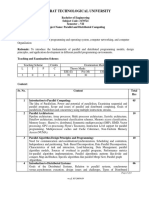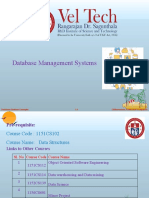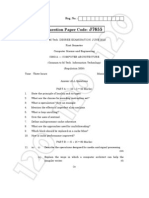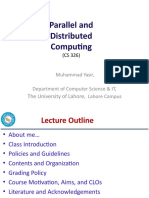CS - 687 Parallel and Distributed Computing
Uploaded by
Noureen ZafarCS - 687 Parallel and Distributed Computing
Uploaded by
Noureen ZafarPMAS Arid Agriculture University Rawalpindi
University Institute of Information Technology
CS- 687 Parallel and Distributed
Computing
Credit Hours: 3(2-3) Prerequisites: None
Teacher:
Course Description:
Asynchronous/synchronous computation/communication, concurrency control, fault
tolerance, GPU architecture and programming, heterogeneity, interconnection
topologies, load balancing, memory consistency model, memory hierarchies, Message
passing interface (MPI), MIMD/SIMD, multithreaded programming, parallel algorithms
& architectures, parallel I/O, performance analysis and tuning, power, programming
models (data parallel, task parallel, process-centric, shared/distributed memory),
scalability and performance studies, scheduling, storage systems, synchronization, and
tools (Cuda, Swift, Globus, Condor, Amazon AWS, OpenStack, Cilk, gdb, threads,
MPICH, OpenMP, Hadoop, FUSE).
Course Objective:
– Learn about parallel and distributed computers.
– Write portable programs for parallel or distributed architectures using Message-Passing
Interface (MPI) library
– Analytical modeling and performance of parallel programs.
– Analyze complex problems with shared memory programming with OpenMP
Teaching Methodology:
Lectures, Assignments, Presentations, etc. Major component of the course should be
covered using conventional lectures.
Courses Assessment:
Exams, Assignments, Quizzes. Course will be assessed using a combination of written
examinations.
Reference Materials:
Distributed Systems: Principles and Paradigms, A. S. Tanenbaum and M. V. Steen,
Prentice Hall, 2nd Edition, 2007
Distributed and Cloud Computing: Clusters, Grids, Clouds, and the Future Internet, K
Hwang, J Dongarra and GC. C. Fox, Elsevier, 1st Ed.
Course Learning Outcomes (CLOs):
At the end of the course the students will be able to: Domain BT Level*
1. Learn about parallel and distributed computers.. C 2
2. Write portable programs for parallel or C 3
distributed architectures using Message-
Passing Interface (MPI)library
3. Analyticalmodelling and performance of parallel
C 3
programs
4. Analyzecomplex problems with shared memory
C 4
programming with openMP.
* BT= Bloom’s Taxonomy, C=Cognitive domain, P=Psychomotor domain, A= Affective
doma
Week/Lecture # Theory
Week 1 Lect- I & Lect-II Introduction, Parallel and Distributed Computing
Parallel and Distrubuted Architectures, Socket
Week 2 Lect-I & Lect-II programming, Flynn’s Taxonomy, Introduction to Multi-
Threading
Week 3 Lect-I & Lect-II Parallel Algorithms & architectures, parallel I/O
Parallel algorithms(data-parallel, task-parallel, process-
Week 4 Lect-I & Lect-II centric, shared/distributed memory)
performance analysis and tuning, scalability and
performance studies
Week 5 Lect-I & Lect-II
Scalable Algorithms, Message Passing
Week 6 Lect-I & Lect-II MPI and Teragrid
scheduling, load balancing, memory consistency model,
Week 7 Lect-I & Lect-II memory hierarchies, Distributed Systems, MapReduce,
Clusters
C GPU architecture and programming, heterogeneity,
Introduction to OpenCL ase Studies: From problem
Week 8 Lect-I & Lect-II specification to a parallelized solution.
Distributed Coordination, Security
Mid Term Exam
Week 9 Lect-I & Lect-II Distributed File Systems, Security
Week 10 Lect-I & Lect-II DFS
Week 11 Lect-I & Lect-II Distributed Shared Memory, Peer-to-Peer
power and energy consumption storage systems, and
Week 12 Lect-I & Lect-II synchronization
Week 13 Lect-I & Lect-II Message passing interface (MPI),concurrency control
Fault tolerance, interconnection topologies,
Week 14 Lect-I & Lect-II Asynchronous/synchronous computation/communication,
concurrency control, fault tolerance.
Advanced topics in parallel and Distributed computing.
Week 15 Lect-I & Lect-II
Cloud Computing.
Week 16 Lect-I & Lect-II Final Project Presentations
Final Term Exam
You might also like
- Final - SRS - of Doctor - Appointment - Booking - System AYUSHNo ratings yetFinal - SRS - of Doctor - Appointment - Booking - System AYUSH62 pages
- Chapter - 11: Access Layer: Object Storage and Object Interoperability100% (1)Chapter - 11: Access Layer: Object Storage and Object Interoperability8 pages
- Subject Name Parallel and Distributed Computing100% (1)Subject Name Parallel and Distributed Computing3 pages
- Department of Information Technology: Question Bank Department: IT Semester: II Class:-BE Subject:-Ubiquitous ComputingNo ratings yetDepartment of Information Technology: Question Bank Department: IT Semester: II Class:-BE Subject:-Ubiquitous Computing4 pages
- Locating Mobile Entities in Distributed Systems67% (3)Locating Mobile Entities in Distributed Systems2 pages
- Lecture 1 - Parallel and Distributed Computing100% (1)Lecture 1 - Parallel and Distributed Computing25 pages
- Database Management Systems: ©silberschatz, Korth and Sudarshan 1.1 Database System ConceptsNo ratings yetDatabase Management Systems: ©silberschatz, Korth and Sudarshan 1.1 Database System Concepts33 pages
- Chapter 3 - Pipelining-And-Vector-Processing100% (1)Chapter 3 - Pipelining-And-Vector-Processing29 pages
- Chapter-10 Parallel Programming Models, Languages and CompilersNo ratings yetChapter-10 Parallel Programming Models, Languages and Compilers30 pages
- Q. Describe Memory Layout of Multiprogramming Operating System. State It's AdvantageNo ratings yetQ. Describe Memory Layout of Multiprogramming Operating System. State It's Advantage9 pages
- Computer Architecture Question Anna UniversityNo ratings yetComputer Architecture Question Anna University2 pages
- From Chapter 1 of Distributed Systems Concepts and Design, 4 Edition100% (1)From Chapter 1 of Distributed Systems Concepts and Design, 4 Edition49 pages
- General Principles of Pipelining: Andrew Warfield CS313No ratings yetGeneral Principles of Pipelining: Andrew Warfield CS31325 pages
- Operating System: Operating Systems: Internals and Design PrinciplesNo ratings yetOperating System: Operating Systems: Internals and Design Principles81 pages
- CS8591-Computer Networks Department of CSE 2020-2021No ratings yetCS8591-Computer Networks Department of CSE 2020-202124 pages
- Mobile Application Development Question PaperNo ratings yetMobile Application Development Question Paper12 pages
- Bahria University Lahore Campus: Department of Computer SciencesNo ratings yetBahria University Lahore Campus: Department of Computer Sciences10 pages
- Parallel and Distributed - CourseoutlineNo ratings yetParallel and Distributed - Courseoutline2 pages
- Institute of Business Administration Karachi: Muhammadsaeed@iba - Edu.pk Saeed@uok - Edu.pkNo ratings yetInstitute of Business Administration Karachi: Muhammadsaeed@iba - Edu.pk Saeed@uok - Edu.pk2 pages
- IM 9000 D0CZ-D0D0-D0D1 Service Manualr Ver. 1.06No ratings yetIM 9000 D0CZ-D0D0-D0D1 Service Manualr Ver. 1.062,677 pages
- DeltaV Remote Client Product Data Sheet (PDS)No ratings yetDeltaV Remote Client Product Data Sheet (PDS)9 pages
- Student-Industrial-Work-Experience-Scheme-SIWES-Report copyNo ratings yetStudent-Industrial-Work-Experience-Scheme-SIWES-Report copy10 pages
- Configuration Data Sheet Roclink 800 Configuration Software Rl800 en 132208100% (1)Configuration Data Sheet Roclink 800 Configuration Software Rl800 en 1322085 pages
- Download full Stability-Constrained Optimization for Modern Power System Operation and Planning (IEEE Press Series on Power and Energy Systems) 1st Edition Yan Xu ebook all chapters100% (1)Download full Stability-Constrained Optimization for Modern Power System Operation and Planning (IEEE Press Series on Power and Energy Systems) 1st Edition Yan Xu ebook all chapters40 pages
- Is 221 ICT Research Methods - Lecture 1No ratings yetIs 221 ICT Research Methods - Lecture 1122 pages
- Motorola Implement A New Human Resource SystemNo ratings yetMotorola Implement A New Human Resource System3 pages
- Linguistic Inquiry and Word Count: LIWC2015: Operator's ManualNo ratings yetLinguistic Inquiry and Word Count: LIWC2015: Operator's Manual22 pages
- eMarketing-Chapter-6-Web-development-and-designNo ratings yeteMarketing-Chapter-6-Web-development-and-design18 pages
- Assignment 2 Getting Started APEX With AnswersNo ratings yetAssignment 2 Getting Started APEX With Answers5 pages

























































































